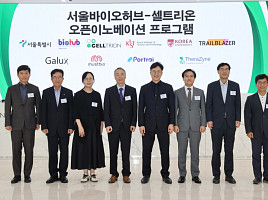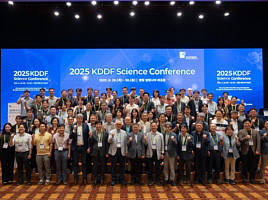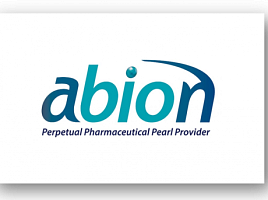기사본문
Ambrx, Site Specific Technology “Next-Generation ADC → Immuno-Oncology drug”
입력 2019-01-28 13:31 수정 2019-01-28 13:31
바이오스펙테이터 Sungmin Kim 기자

Ambrx is a company of unique history. Since its foundation in 2003 in Los Angeles, it has established partnership with big pharmaceutical companies, such as BMS (2011), Astellas (2013), and Eli Lilly (2007), based on site-specific Protein Medicinal Chemistry™ platform technology. In 2015, Ambrx was acquired by Chinese companies, namely Fosun and WuXi PharmaTec. Thereafter, the company has sought partnership with Asian pharmaceutical companies in Korea and in China. Recently, Ambrx invited a total of 45 million USD from investment institutions in Korea, China, and Canada in 2016.
“Ambrx is the only company that can modify/manipulate protein site specifically by exploiting artificial amino acid technology in the animal cell system. It is the domain we do best. The field of pharmaco-chemical discipline, capable of freely modifying or manipulating protein drugs, is opened. Ambrx is currently exploiting its technology to extend immuno-oncology agent from ADC”, Feng Tian, the president of Ambrx, explained.
Feng Tian worked as post-doctoral researcher in The Scripps Research Institute (TSRI) of Peter G. Schultz, who had developed the platform technology of Ambrx, and joined the company in earlier times. He became president in 2015, after he had worked as Chief Scientific Officer (CSO). President Feng led the EuCODE™ Platform and Double-Antibody technologies of Ambrx, and played a key role in expanding business in China.
Ambrx is developing the next-generation ADC, and two clinical trials of ADC are in progress. Recently, the company has changed direction with the recent portfolio expanded to include immuno-oncology agent. President Feng opened its portfolio of immuno-oncology portfolio in front of a reporter from BioSpectator.
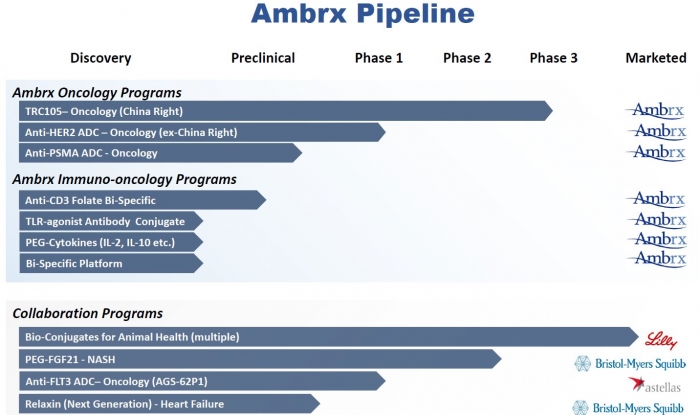
① Congenital Immuno-Factor: Interleukin, TLR portfolio
PEGylation is the fastest program run by Ambrx, and is an interleukin agent of which the half-life has been extended. Currently, the candidate materials for anticancer agent of extended half-life, such as IL-2, IL-10, and IL-7, are being developed. President Feng explained, “… the cytokines of Ambrx exhibit better efficacy and safety, due to the exploitation of site-specific technology…”; “… however, unless the control of the part combining with PEG is disabled, it would kill molecules…”
Ambrx is currently developing IL-2 agent. By exploiting site-specific PEGylation, Ambrx has selectively combined the IL-2 agent with beta/gamma receptor. President Feng explained, “… IL2 can exhibit a synergistic effect with immuno-anticancer agent with the mechanism activating immunity…”; “… however, we are afraid of excessive immunity, owing to the activation of congenital immunity…”. President Feng stated, “… Since the alpha-receptor and beta/gamma receptor are similar to each other, distinguishing the two from each other is essential for the IL-2 agent…”; “… Nektar therapeutics is a non-specific PEGylation, and failed to control the degree of combination of agent with each receptor. Unless the control is disabled, it cannot be used as a drug…”.

Next, the IL-10 Project is being accelerated. IL-10 combines with CD4+ and CD8+ T cells, and promotes the proliferation and survival of cells. President Feng explained, “…the IL-10 PEGylation agent of Ambrx exhibited excellent in vitro anticancer efficacy; in particular, it manifested excellent efficacy for gastric cancer.”. “… contrary to the IL-10 PEGylation agent of Amotherapeutics, which is a non-specific PEGylation existing in three types, the agent of Ambrx is of single type, and is homogenous, exhibiting an excellent PK profile. In addition, its efficacy was optimized through the structure activity relationship (SAR) of protein …”. A similar approach was employed by Synthrox, which is in the stage of pre-clinical trial. The company announced an IPO on NASDAQ for the clinical trials.
There are other approaches. It is a site-specific combination of toll-like receptor (TLR) with existing antibody agent (bio-medicine). It is an agent that was designed for the immune system to be selectively activated at the site of tumor, to avoid the side effect of the activation of excessive immunity. Currently, it is focused on TLR7 and TLR8, of which the clinical efficacies have been manifested.
② BITE of Extended Half-life
The T-cell engager, the agent introducing T-cells into tumor site, is being developed. It is intended to overcome the existing CMC issues and short half-life of the BiTE platform of AMGen. By exploiting the site-specific technology, Ambrx combined folate receptor that aims for cancer cells with CD3 Fab introducing T-cells. President Feng said, “… if necessary, the half-life of agent can be controlled by adjusting the magnitude of PEGylation…”; “… the half-life of BiTE in the experiment with mouse was 20 minutes. However with our platform, we have demonstrated a half-life of 10 hours …”
The administration of agent to the model of ovarian cancer in pre-clinical trial resulted in 100 % removal of all tumors in mice. Further, the mice did not exhibit the recurrence of tumor after five months. Ambrx intends to expand the application of the agent to other solid cancer, such as lung cancer and breast cancer.

③Productivity, Half-body of Improved Half-life
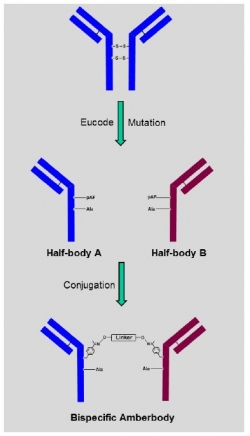
The last product is the Half-body, the IgG like bi-specific antibody. President Fend explained, “… currently, there are similar technologies for the antibody. Thereby, it lacks diversity. However, the Ambrx approach is different. We can start with new platforms. It is a new agent ...”. The half-body is a platform that enables control of the effector function of antibody, improves PK characteristics, and minimizes the target-off effect. Currently, Ambrx has filed an application for a patent.
The differentiation of Half-body comes from its production. The existing hybrid antibody has the disadvantages of low production yield, due to the separate production of antibodies aiming at different targets, and of homodimer; the antibodies aiming at the same target are combined with each other. In addition, the half-life of the double antibody was short. President Feng explained, “… the half-body of Ambrx specifically combines with existing antibody site, thereby resulting in more than 99 % of antibodies combined with other target…”; “… the half-life is extended by the higher ratio of sialic acid inserted into part of Fc, with reduced effector function that could cause immuno side effect…”



